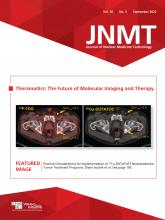Abstract
Benign metastasizing leiomyomas are benign disseminated extrauterine tumors in patients with prior history of uterine leiomyomas and may occur years after hysterectomy. The lung is mostly affected, with a less common occurrence in the brain, heart, spine, retroperitoneum, and bone. We present the role of 18F-FDG PET/CT in the metabolic staging and postsurgical monitoring of a patient with lung and femoral involvement.
A case of pulmonary and osseous benign metastasizing leiomyoma is presented with 18F-FDG PET/CT imaging.
CASE REPORT
A 76-y-old woman had a 6-mo history of right hip pain with MRI detection of a right femoral diaphyseal intramedullary lesion. Further CT imaging showed a left hemithoracic mass with chest wall and rib invasion. Contemporary 18F-FDG PET/CT (Fig. 1) showed borderline hypermetabolic left lung mass (SUV, 4.2) and right femoral lesion (SUV, 3.4). Subsequent CT-guided biopsy of both lesions showed spindle cell features considered as synchronous metastatic smooth cell neoplasm, with immunostains positive for desmin, estrogen receptor, and progesterone receptor and negative for pancytokeratin, CK5/6, S100, CD117, and CD10. Her clinical history was remarkable for a total abdominal hysterectomy and bilateral salpingo-oophorectomy for uterine leiomyoma 15 y before the present event. These lesions were consistent with benign metastasizing leiomyoma (Fig. 2). The patient underwent the left thoracic and right femoral tumor resection with right hip arthroplasty. No residual or recurrent tumor was detected during the subsequent 6-y PET/CT surveillance.
Anterior PET maximum-intensity-projection image shows the borderline hypermetabolic lesions of left thorax and right proximal femur (A, arrows). (B–G) Corresponding axial, sagittal, and coronal fused PET/CT of the mass of lung and chest wall (B–D, arrows) and of proximal right femur (E–G, bone window, arrows).
Corresponding radiograph of the right femur before resection (A), coronal contrast-enhanced MR image (B), photograph of surgical specimen (C), and radiograph of surgical specimen (D) of proximal femoral lesion.
DISCUSSION
Benign metastasizing leiomyoma (BML) is a rare disease characterized by histologically benign extrauterine smooth cell metastatic tumors in patients with prior history of uterine leiomyomas. BML may occur years after hysterectomy for benign uterine leiomyomas; however, few cases have been reported in women without previous uterine surgery (1). The lung is the site most affected, with rare involvement of the brain, heart, spine, retroperitoneum, and bone (1–3). Although several theories detail the route of metastasis, the etiology and pathogenesis of BML still remain unclear. A few theories suggest a metaplastic process or hematologic spread of uterine leiomyomatous tissue at the time of hysterectomy (1). Even though MR and CT depicted well the femoral and chest tumors in our patient, 18F-FDG PET/CT provided the metabolic characteristics of these lesions, the whole-body assessment for potential additional lesions/metastasis, and the postsurgical surveillance of BML. Leiomyosarcomas are 18F-FDG–avid, whereas BML typically lacks tracer uptake. However, a small proportion of BML may exhibit mild borderline tracer uptake as seen in our case (2). 18F-FES (16α-18F-fluoro-17β-estradiol) PET/CT may provide useful information about BML estrogen receptor expression with an option for antihormonal therapy (4). Histologically, the absence of cellular atypia and low mitotic activity favor a diagnosis of BML. However, low-grade and slow-growing leiomyosarcoma cannot be totally excluded from the differential diagnosis even with benign histologic features.
CONCLUSION
BML is of rare occurrence. PET/CT is a useful functional imaging modality for a comprehensive evaluation and posttherapeutic surveillance of this potentially multifocal disease.
DISCLOSURE
No potential conflict of interest relevant to this article was reported.
Footnotes
Published online Jul. 26, 2022.
- Received for publication January 22, 2022.
- Accepted for publication March 14, 2022.









